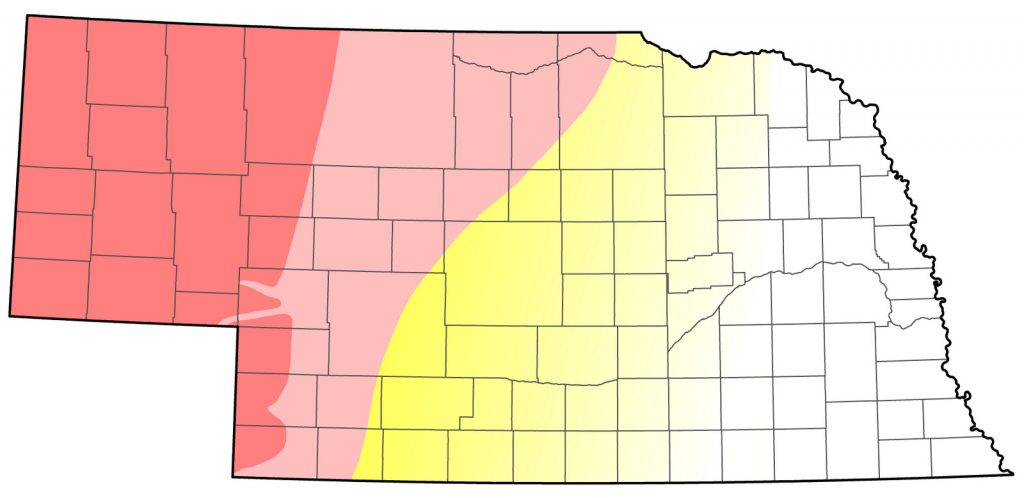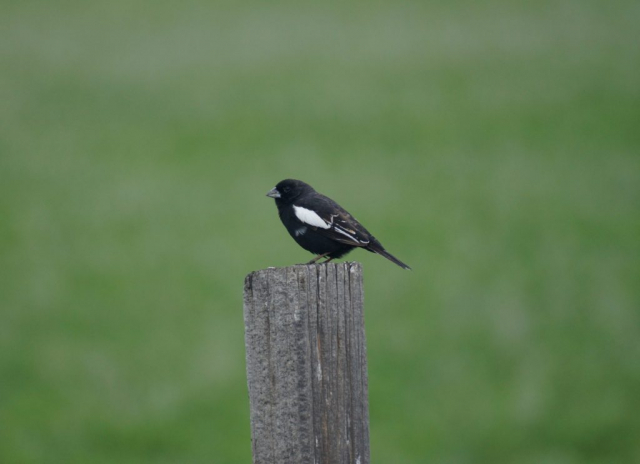Calamospiza melanocorys
Status: Abundant regular spring and fall migrant west and west-central, uncommon east-central and northeast, rare casual southeast. Common regular breeder west, uncommon west-central, rare casual elsewhere.

Documentation: Specimen: UNSM ZM12193, 30 May 1895 Lincoln, Lancaster Co.
Taxonomy: No subspecies are recognized (AviList 2025).
Spring: Apr 27, 28, 28 <<<>>> summer
An earlier date is 19 Apr 2008 Lincoln Co.
Migrants generally appear in early May and peak numbers occur in late May.
There were spring records of Lark Bunting in the east in 17 of the 30 years during the period 1986-2015, 12 of those records in the period 1986-1993; this species tends to appear east of its usual summer range in dry years. The only records in the southeast since 1993 are 4 May 2024 Saunders Co, 10 May 2009 Fillmore Co, 12 May 2024 Seward Co, 17 May 2013 Jefferson Co, 20 May 2014 Washington Co, two in York Co 20 May 2019, and 1 Jun 2018 York Co.
- High counts: “thousands” in Kimball Co 30 May 2011, 500 in Perkins Co 26 May 2013, 500 in Kimball Co 25 May 2019, 400 in Banner Co (350 in one flock) 21 May 2016, and 305 in Kimball Co 23 May 2012.
Summer: Breeding numbers are erratic, and their distribution is variable; Lark Buntings can be abundant in the Panhandle, with largest numbers occurring in dry years when birds may also be found further east. BBS data 2011-2015 reflect high densities in the west, declining into the central and absent in the east. Lark Buntings have declined -1.02% (95% C.I.; -3.88, 1.78) in Nebraska during the period 1966-2019 (Sauer et al 2020). Mollhoff (2016) showed a marked decline in the proportion of BBA blocks in which the species was reported between the first and second BBA projects, even though overall observer effort increased. Most of the decline appears to be along the eastern edge of the species range, which appears to have retreated west over time, although this conclusion is confounded by the erratic and variable distribution of the species during summer.
Even prior to the conversion of tall grass prairie to agriculture, Lark Bunting was rare in the east (Bruner et al 1904). Ducey (1988) and Mollhoff (2022) cited nesting records in Madison, Cuming, Douglas, Lancaster, Seward, Otoe, Gage, and Nemaha Cos prior to 1920 and none for 1921-1960. Post-1960, however, Ducey (1988) cited records in Adams, Clay, Greeley, Hall, and Howard Cos. An additional record was in York Co (Bennett 1971). There are no eastern breeding records since the early 1970s even though there have been extended dry periods (e.g., early 2000s). Nesting occurred in northeast Cherry Co in 1982 (Brogie and Mossman 1983), a BBS route along the Rock-Brown Cos line yielded “several” 16 Jun 1995, and the most easterly confirmed breeding record shown in Mollhoff (2016) was in Hayes Co.
Occurrence of Lark Buntings further east during dry years was noted by Tout (1902) who stated that they become “rare in rainy or wet years and quite common during years of drouth” in York Co in the late 1800s. Jorgensen (2012) outlined the variation in summer occurrence in the Rainwater Basin, where the last cycle of multiple reports was 1965-1976; spring records (above) suggested another dry cycle 1986-1993. There are scattered breeding season reports in the east, without evidence of nesting; most are during the dry years of the 1980s. These are 4-20 Jun 1989 Douglas-Sarpy Cos, 8 Jun-24 Jul 1985 Polk Co, 10 Jun 1982 Sarpy Co (Williams 1982), 16 Jun 1989 Sarpy Co (Grzybowski 1989), 22 Jun 1989 Cedar Co, 26 Jun 2014 Knox Co, 30 Jun-4 Aug 1988 Lancaster Co, 30 Jun 1988 Adams Co, 8 Jul 1995 Franklin Co, 8 Jul 2023 Merrick Co, and 11 Jul 2015 Richardson Co.
Lark Buntings occasionally nest in agriculture fields. Such was the case when “many” were nesting in milo stubble in Clay County In 1965 (Cortelyou 1966), and 30-40 were using a growing cornfield no tilled into the previous year’s wheat stubble 28 Jun 2007 in Lincoln Co.
- Breeding phenology:
- Nest building: 4 Jul
- Copulation: 17 Jun
- Eggs: 4 May- 5 Aug (Mollhoff 2022)
Nestlings: 20 Jun-27 Jul
Fledglings: 3 Aug
- High counts: 400 in Kimball Co 15 Jun 1997, 350 in Sioux Co 14 Jun 1997, and 300 in Sioux Co 9 Jun 2023.
Fall: summer <<<>>> Sep 26, 26, 27
Later dates are 30 Sep 2022 Scotts Bluff Co, and very late 26 Oct 2018 Custer Co.
Most birds depart the state by mid-Sep. Post-breeding flocks form as early as late Jul; two flocks of 30 were seen in Scotts Bluff Co 27 Jul 2003.
Reports from the east are few: a female in Seward Co 4 Aug 2012, a female there 10 Aug 2024, 18 Aug 2009 Hamilton Co, a female in Dodge Co 6 Sep 2012, and 7 Sep 1985 Pierce Co.
There are no documented Nebraska records for Nov-Mar, although one was in northeastern Colorado 20 Nov 2011 (eBird.org, accessed Dec 2023). Wintering has become essentially annual, albeit cyclical, in southwest Kansas in recent years (Thompson et al 2011).
- High counts: 600 in Box Butte Co 12 Aug 1994, 560 one flock north of Oshkosh, Garden Co 1 Aug 2024, 484 at Bushnell, Kimball Co 26 Jul 2025, and 400 in Sioux Co 29 Jul 2024.
Images
Abbreviations
BBA: Breeding Bird Atlas
BBS: Breeding Bird Survey
NWR: National Wildlife Refuge
UNSM: University of Nebraska State Museum
Literature Cited
AviList Core Team, 2025. AviList: The Global Avian Checklist, v2025. https://doi.org/10.2173/avilist.v2025.
Bennett, E.V. 1971. 1970 Nebraska nesting survey. NBR 39: 10-15.
Brogie, M.A., and M.J. Mossman. 1983. Spring and summer birds of the Niobrara Valley Preserve, Nebraska: An annotated checklist. NBR 51: 44-51.
Bruner, L., R.H. Wolcott, and M.H. Swenk. 1904. A preliminary review of the birds of Nebraska, with synopses. Klopp and Bartlett, Omaha, Nebraska, USA.
Cortelyou, R.G. 1966. Nesting Report, 1965. NBR 34: 41-43.
Ducey, J.E. 1988. Nebraska birds, breeding status and distribution. Simmons-Boardman Books, Omaha, Nebraska, USA.
Grzybowski, J.A. 1989. Southern Great Plains Region. American Birds 43: 1334-1336.
Jorgensen, J.G. 2012. Birds of the Rainwater Basin, Nebraska. Nebraska Game and Parks Commission, Lincoln, Nebraska, USA.
Mollhoff, W.J. 2016. The Second Nebraska Breeding Bird Atlas. Bull. Univ. Nebraska State Museum Vol 29. University of Nebraska State Museum, Lincoln, Nebraska, USA.
Mollhoff, W.J. 2022. Nest records of Nebraska birds. Nebraska Ornithologists’ Union Occasional Paper Number 9.
Sauer, J.R., W.A. Link and J.E. Hines. 2020. The North American Breeding Bird Survey – Analysis Results 1966-2019. U.S. Geological Survey data release, https://doi.org/10.5066/P96A7675, accessed 27 Jul 2023.
Thompson, M.C., C.A. Ely, B. Gress, C. Otte, S.T. Patti, D. Seibel, and E.A. Young. 2011. Birds of Kansas. University Press of Kansas, Lawrence, Kansas, USA.
Tout, W. 1902. Ten years without a gun. Proceedings of Nebraska Ornithologists’ Union 3: 42-45.
Williams, F. 1982. Southern Great Plains Region. American Birds 36: 992-995.
Recommended Citation
Silcock, W.R., and J.G. Jorgensen. 2025. Lark Bunting (Calamospiza melanocorys). In Birds of Nebraska — Online. www.BirdsofNebraska.org
Birds of Nebraska – Online
Updated 3 Sep 2025

